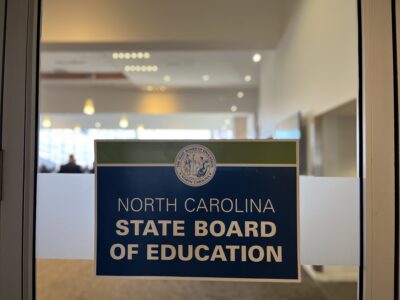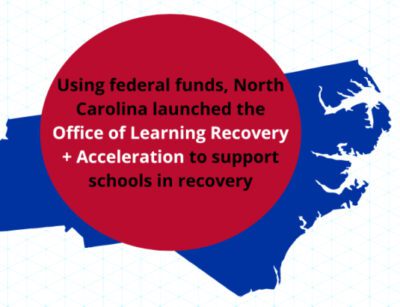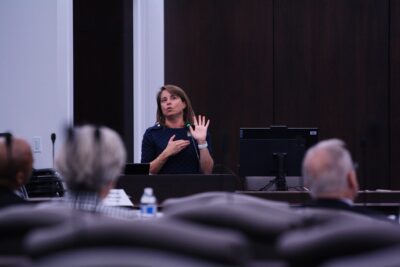|
|
The Department of Public Instruction (DPI) presented new data this week on COVID-19 learning recovery during a House committee meeting on education reform — with data showing gains in nearly every grade and subject from last year.
The presentation was given on Monday by Dr. Jeni Corn, director of research and evaluation in DPI’s Office of Learning Recovery and Acceleration (OLR). Her report included data from DPI’s 2023 Year-Over-Year State Analysis Report, which she presented to the State Board of Education in early January.
The state budget provided funds for DPI to partner with SAS for this year-over-year analysis of student learning before, during, and after the pandemic. The analysis measures students’ standardized test scores from 2013 to 2023.
“The data from this new Year-Over-Year report allows state and local leaders to better understand the impact of the pandemic within the context of historical performance on standardized assessments,” Corn said. “Using this ten-year lens for the first time, education leaders can set recovery targets empirically and focus on those tested subjects where supports are most needed.”
What is learning recovery?
State Superintendent Catherine Truitt created the OLR in March 2021 to help find and make evidence-based decisions regarding recovery from lost instructional time during the start of the pandemic.
Prior to the pandemic, per DPI’s presentation, achievement was relatively stable for most assessments across the state — with small positive or negative trends. That has changed since the start of the pandemic, DPI said, with current data showing “considerably more variation.”
The new year-to-year model provides insight into pre-pandemic trends, pandemic impact, and distance to a full recovery.
“This is a more robust way to measure trends than simple pre/post comparison of district averages,” the DPI presentation says. “The model considers trends in achievement prior to the pandemic.”
The new learning recovery analysis — which was allocated $550,000 in the budget for each year of the biennium — was developed with the following questions in mind, per DPI’s presentation.
- How will we know when the state/district/schools have “recovered” in North Carolina?
- Can we quantify “recovery”?
- How can we account for local context in terms of progress towards “recovery”?
Here’s a broad look at the data from the resulting report.
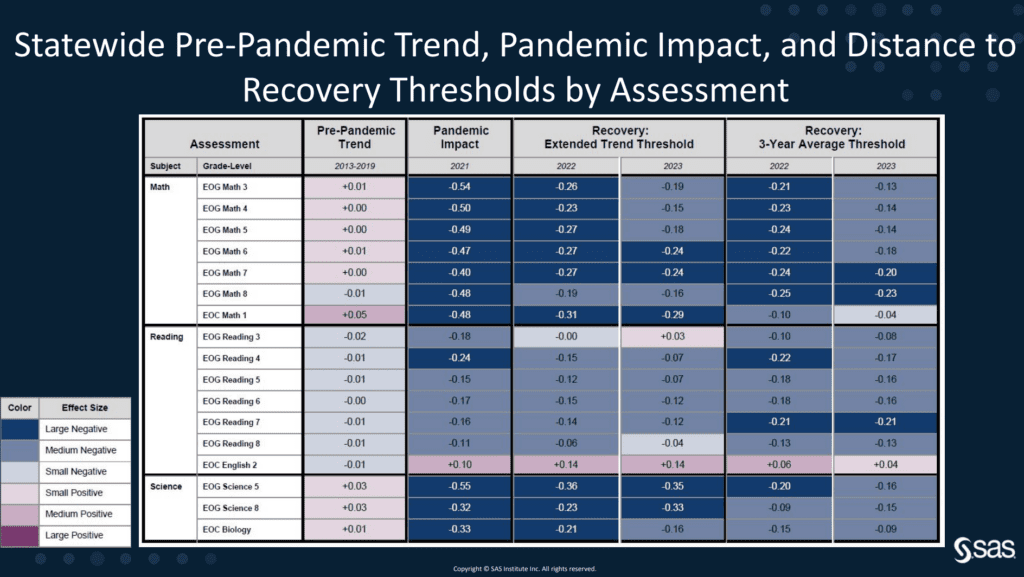

And here’s a look at the percentage of schools with overall improvement from 2021 to 2023.
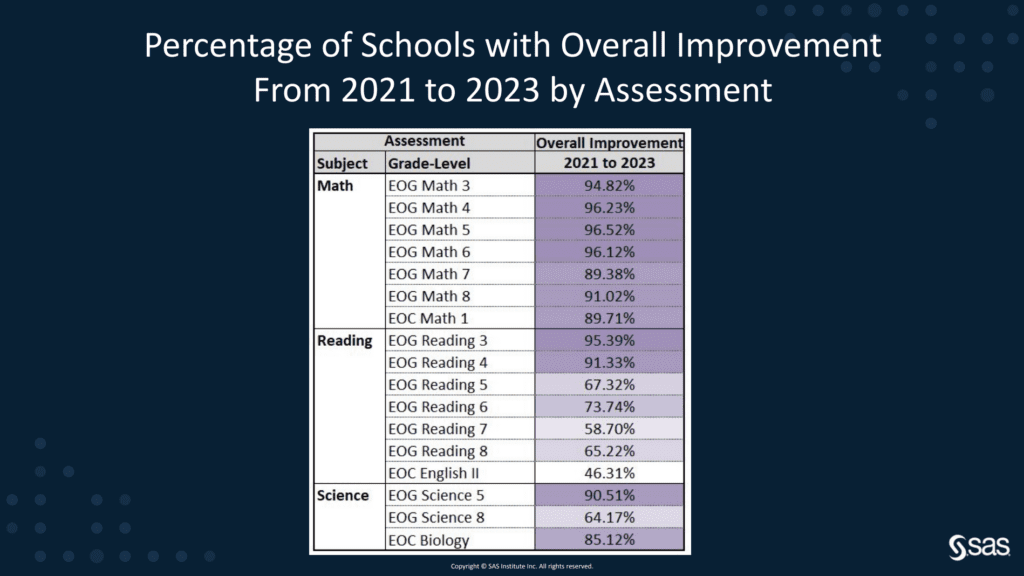

Highlights from recovery data
The new report shows gains across nearly all grades and subjects, per DPI’s presentation. However, most of the assessments are still below pre-pandemic levels.
Two of 16 standardized assessments (EOG Reading Grade 3 and EOC English II) already show gains above the recovery thresholds, per a DPI press release.
The strongest gains were measured in EOG Reading Grade 3.
“That’s a very positive story, a very positive subject and grade,” John White, vice president of SAS EVAAS for K-12, said at the State Board’s January meeting.
Per DPI, “notable gains” were also found in reading and math for grades 3-5 and science grade 5.
“The new report shows there continues to be room for improvement in math, as it was more negatively impacted by the pandemic than reading,” the DPI release says. “Math assessments have a greater distance to the recovery thresholds both one year and two years later than reading.”
While a few assessments showed no change from 2022 to 2023, the only decrease shown in the data is in the EOG for eighth grade science.
“While the drop in overall school performance in Science Grade 8 in 2023 was unexpected, NCDPI is working with experts in the field to better understand the possible causes of the drop in performance and identify promising STEM-focused interventions to accelerate science learning for middle school students,” the DPI release says.
Corn said DPI plans to invest in the following strategies, based on the new data:
- Build on early grades literacy and math progress.
- Focus on targeted and evidence-based middle grades reading and math interventions.
- Explore promising STEM initiatives aligned to workforce priorities.
- Study and identify evidenced-based interventions and collaborate with external research partners.
“Our continued improvement as identified in this report is a testament to the commitment and diligence of educators across North Carolina and a result of what can be done when there is intentionality in strategically implementing programming to support students who were most affected by the pandemic,” Truitt said in the release. “This report provides the information we need to continue designing academic programming in subjects where students need additional support while allowing us to better target resources to specific grades and content areas. …North Carolina’s students are resilient, and I know we will continue to see improvements with time.”
Check out the full presentation below, which includes an overview of trends for every assessment/grade. You can also look at recovery data presented at Monday’s meeting from the Randolph County School System.
Student devices and home connectivity
DPI also gave a presentation on student devices, home connectivity, and artificial intelligence (AI) guidelines at Monday’s House committee meeting, led by Dr. Vanessa Wrenn, DPI’s chief information officer.
Every year since 1996, DPI has collected data for the North Carolina Digital Learning and Media Inventory (DLMI), which is completed by schools and districts every June. All DLMI data is self-reported.
There are 1.98 million student devices in public schools across the state, according to DLMI data presented on Monday. This includes labs, mobile carts, spare devices, and damaged devices used for spare parts.
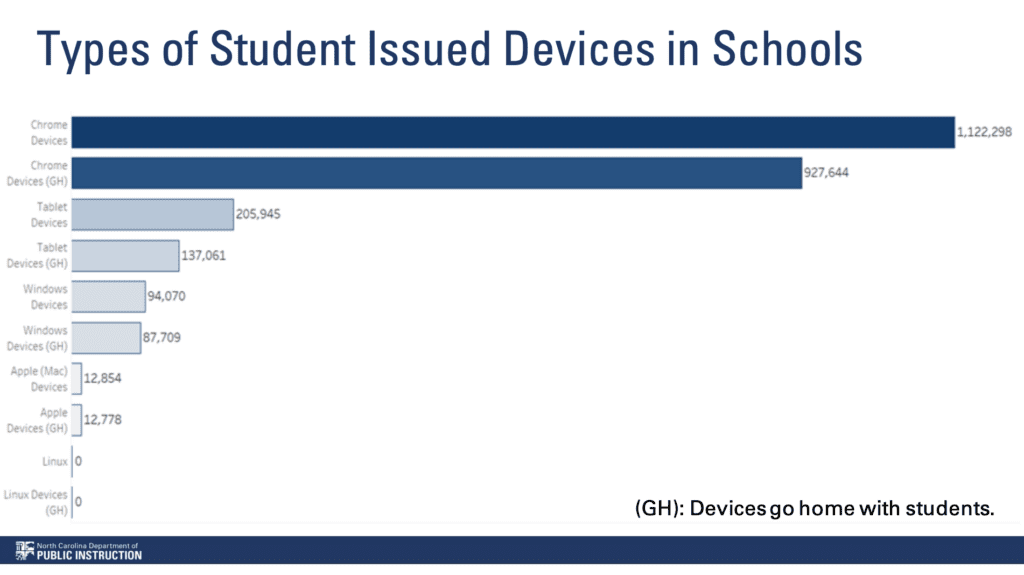

Currently, 114 of 115 school districts have one device per student, the presentation says. Students can take such devices home with them to help with studying and homework. At charter schools, that number is 162 schools out of 215.
However, 89 of 115 districts have reported they do not currently have sufficient resources “to sustain their refresh cycles for student devices beyond ESSER funding.” That’s more than 77% of districts.
With warranty, the average cost of each student device is $525, with a 4-5 year average life span.
Research shows that providing students with computer devices is an important part of equitable access to technology. Disparities in digital access contribute to “the homework gap” between students with and without reliable WiFi and technology.
At least 1.1 million North Carolina households lack access to high-speed internet, cannot afford it, or do not have the skills to use it, per NC Broadband Office data included in the presentation. The parent response rate to the survey aligns with N.C. Broadband Office response rates of approximately 2.3%, according to the presentation.
That data shows that about 65% of households without internet lack connectivity to due to geographic location.
According to DLMI’s statewide data on student internet access reported by families, nearly 90% of students do have “consistent internet access at home that is adequate to complete schoolwork.”
DPI highlighted hotspot programs and school bus WiFi as two strategies to expand digital access for students. Approximately 7% of N.C. public schools reported using school bus WiFi for access to students outside of school.
“I think it can be valuable on activity buses where students are spending a long-time on buses,” said one district technology director quoted in DPI’s presentation. “We do not see the advantage for most of our bus routes, we only see it as something else for a bus driver to have to manage. I would consider a handful of activity buses, but not yellow school buses.”
The committee’s next meeting is Feb. 12.



